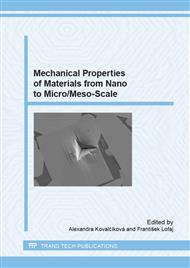p.69
p.73
p.77
p.81
p.87
p.91
p.95
p.99
p.103
Characterization of Sputter-Deposited NiTi Thin Film by Nanoindentation
Abstract:
NiTi shape memory alloy thin film sputter-deposited on a large scale silicon wafer was characterized by means of instrumented (depth-sensing) indentation technique. Thickness of deposited thin film was measured by calotest device. Microstructure of thin film was observed using differential interference (Nomarski) contrast. It was shown that the local mechanical properties are different in areas containing different phases (austenite and martensite) according to different deposition conditions (kinetic energy of deposited atoms when impacting the substrate surface).
Info:
Periodical:
Pages:
87-90
Citation:
Online since:
September 2015
Authors:
Keywords:
Price:
Сopyright:
© 2015 Trans Tech Publications Ltd. All Rights Reserved
Share:
Citation:


